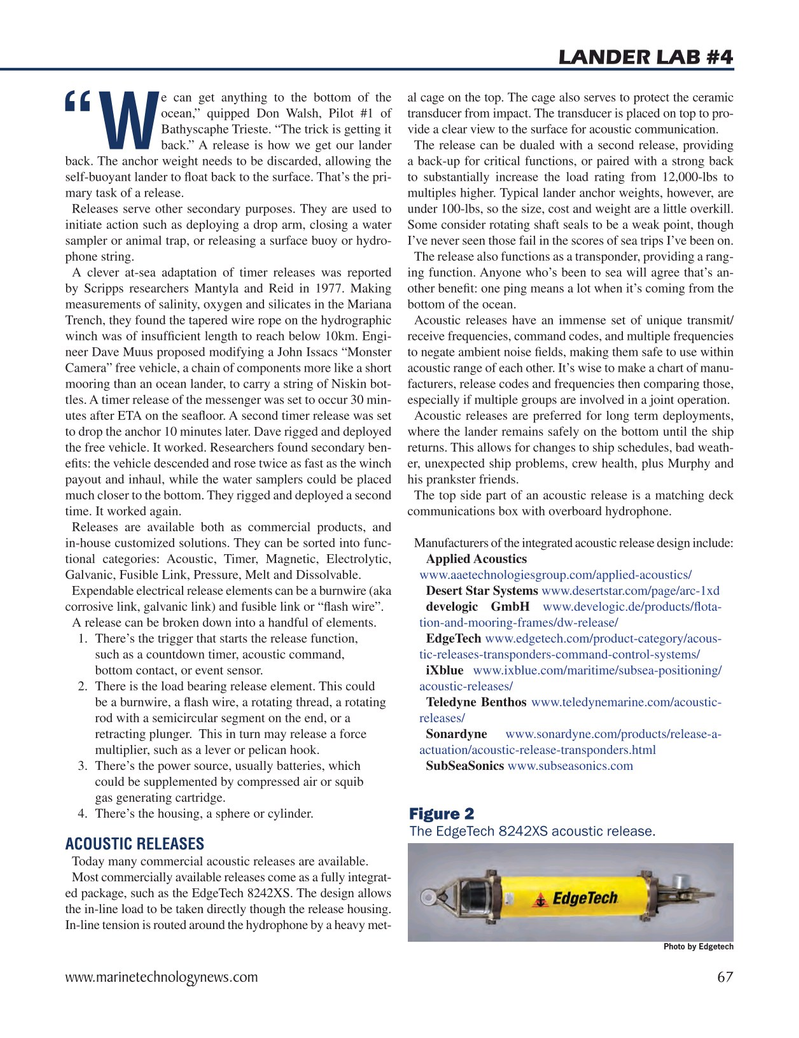
Page 67: of Marine Technology Magazine (September 2022)
Read this page in Pdf, Flash or Html5 edition of September 2022 Marine Technology Magazine
LANDER LAB #4 e can get anything to the bottom of the al cage on the top. The cage also serves to protect the ceramic ocean,” quipped Don Walsh, Pilot #1 of transducer from impact. The transducer is placed on top to pro-
Bathyscaphe Trieste. “The trick is getting it vide a clear view to the surface for acoustic communication. “Wback.” A release is how we get our lander The release can be dualed with a second release, providing back. The anchor weight needs to be discarded, allowing the a back-up for critical functions, or paired with a strong back self-buoyant lander to ? oat back to the surface. That’s the pri- to substantially increase the load rating from 12,000-lbs to mary task of a release. multiples higher. Typical lander anchor weights, however, are
Releases serve other secondary purposes. They are used to under 100-lbs, so the size, cost and weight are a little overkill. initiate action such as deploying a drop arm, closing a water Some consider rotating shaft seals to be a weak point, though sampler or animal trap, or releasing a surface buoy or hydro- I’ve never seen those fail in the scores of sea trips I’ve been on.
phone string. The release also functions as a transponder, providing a rang-
A clever at-sea adaptation of timer releases was reported ing function. Anyone who’s been to sea will agree that’s an- by Scripps researchers Mantyla and Reid in 1977. Making other bene? t: one ping means a lot when it’s coming from the measurements of salinity, oxygen and silicates in the Mariana bottom of the ocean.
Trench, they found the tapered wire rope on the hydrographic Acoustic releases have an immense set of unique transmit/ winch was of insuf? cient length to reach below 10km. Engi- receive frequencies, command codes, and multiple frequencies neer Dave Muus proposed modifying a John Issacs “Monster to negate ambient noise ? elds, making them safe to use within
Camera” free vehicle, a chain of components more like a short acoustic range of each other. It’s wise to make a chart of manu- mooring than an ocean lander, to carry a string of Niskin bot- facturers, release codes and frequencies then comparing those, tles. A timer release of the messenger was set to occur 30 min- especially if multiple groups are involved in a joint operation. utes after ETA on the sea? oor. A second timer release was set Acoustic releases are preferred for long term deployments, to drop the anchor 10 minutes later. Dave rigged and deployed where the lander remains safely on the bottom until the ship the free vehicle. It worked. Researchers found secondary ben- returns. This allows for changes to ship schedules, bad weath- e? ts: the vehicle descended and rose twice as fast as the winch er, unexpected ship problems, crew health, plus Murphy and payout and inhaul, while the water samplers could be placed his prankster friends.
much closer to the bottom. They rigged and deployed a second The top side part of an acoustic release is a matching deck time. It worked again. communications box with overboard hydrophone.
Releases are available both as commercial products, and in-house customized solutions. They can be sorted into func- Manufacturers of the integrated acoustic release design include: tional categories: Acoustic, Timer, Magnetic, Electrolytic, Applied Acoustics
Galvanic, Fusible Link, Pressure, Melt and Dissolvable. www.aaetechnologiesgroup.com/applied-acoustics/
Expendable electrical release elements can be a burnwire (aka Desert Star Systems www.desertstar.com/page/arc-1xd corrosive link, galvanic link) and fusible link or “? ash wire”. develogic GmbH www.develogic.de/products/? ota-
A release can be broken down into a handful of elements. tion-and-mooring-frames/dw-release/ 1. There’s the trigger that starts the release function, EdgeTech www.edgetech.com/product-category/acous- such as a countdown timer, acoustic command, tic-releases-transponders-command-control-systems/ bottom contact, or event sensor. iXblue www.ixblue.com/maritime/subsea-positioning/ 2. There is the load bearing release element. This could acoustic-releases/ be a burnwire, a ? ash wire, a rotating thread, a rotating Teledyne Benthos www.teledynemarine.com/acoustic- rod with a semicircular segment on the end, or a releases/ retracting plunger. This in turn may release a force Sonardyne www.sonardyne.com/products/release-a- multiplier, such as a lever or pelican hook. actuation/acoustic-release-transponders.html 3. There’s the power source, usually batteries, which SubSeaSonics www.subseasonics.com could be supplemented by compressed air or squib gas generating cartridge.
4. There’s the housing, a sphere or cylinder.
Figure 2
The EdgeTech 8242XS acoustic release.
ACOUSTIC RELEASES
Today many commercial acoustic releases are available.
Most commercially available releases come as a fully integrat- ed package, such as the EdgeTech 8242XS. The design allows the in-line load to be taken directly though the release housing.
In-line tension is routed around the hydrophone by a heavy met-
Photo by Edgetech www.marinetechnologynews.com 67
MTR #7 (66-79).indd 67 9/28/2022 7:12:49 PM

 66
66

 68
68
